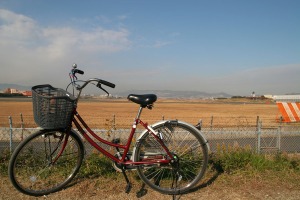8/31/15: This page is still under construction. Please check back for future updates!
Cycling is very common everywhere in Miyazaki. If you are in a rural area, you will also have the benefit of some truly epic unspoiled scenery. In the city, don’t hesitate to take detours or side-streets; with its at times chaotic street grid, you’ll find real gems everywhere you go in Japan if you let yourself get lost a little bit.
So, get on your bike and go explore rice field roads, vintage alleys, markets, bamboo forests, beachfronts, and residential neighbourhoods.
Almost everyone in Japan bikes on what is called a mamachari. They are easy to find, both used and new in shops, and shouldn’t cost you an arm and a leg.
Mamacharis definitely get the job done, and 95% of cyclists will have absolutely no problems riding one. Keep in mind however that they aren’t particularly fast or efficient machines, and that if you’re very tall, they can be a bit painful to your lower back.
Due to the overwhelming popularity of mamacharis, if you’re interested in road bikes or more high-end bikes in general, you may be hard pressed to find a shop outside of major urban areas. Check out Japan Cycling Navigator‘s page on types of bicycles in Japan.
Registering your Bicycle
Most importantly, you should make sure your bike is registered to your name. Getting stopped by the police while riding an improperly registered bike will make things very complicated for you. Not only will you be asked to explain yourself, but it will also likely result in your bike being confiscated on the basis of it being deemed stolen.
Don’t worry though, registration is really straightforward. At the time of purchase, your bike shop will ask you for photo ID and help you fill a short registration form for a nominal fee of ¥500. Otherwise, you can register your bike at a police station with your purchase receipt and a piece of photo ID in hand.
If you are buying your bicycle secondhand, things can get a tiny bit more complicated, so do your research ahead of time. Drop by or call your local police station to ask what you’ll need to transfer ownership of a bike to your name. On top of your photo ID, you’ll likely need a copy of the previous owner’s bike registration card (防犯登録お客様控え bouhan touroku okyakusama hikae or 登録カード touroku kaado) and a signed Change of Ownership form (譲渡証証明書, joutoshoumeisho). Unless the bike is stolen, transferring ownership will be straightforward.
Bicycle Laws
In general, cycling laws are the same as driving laws, with some exceptions. Furthermore, you’ll find that many laws are not strictly enforced, but this is not an excuse to break them! In fact, due to an increase in the number of bicycle-related incidents, as of June 1, 2015, Japanese police officials have launched a campaign to enforce bicycle laws.
For the most part, bicycle safety is common sense:
- Don’t carry things in your hands while riding (umbrellas, phones, mp3 players, etc.).
- Be sure to have a front light and functioning brakes.
- No more than one rider per bicycle.
- Stay in the designated bike lanes. (Technically, cyclists are not allowed to use the sidewalk unless there is a sign allowing it, but most police officers will not cite you for doing so.)
- Don’t ride recklessly. (Pay attention to your surroundings, come to a full stop with your feet on the ground at traffic lights and stop signs, avoid colliding with anyone or anything, etc.)
- Don’t drink and ride. (Just don’t.)
However, we also advise you to review these Traffic Safety Guidelines for Pedestrians and Cyclists.

